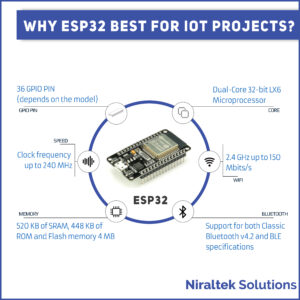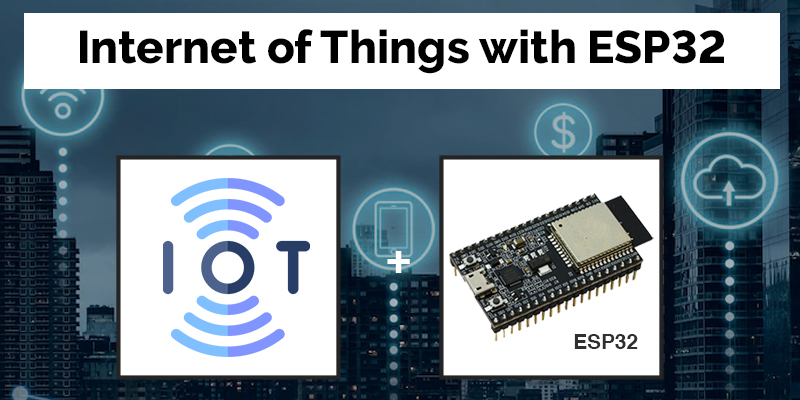Internet of Things with ESP32
When IoT is discussed, ESP32 appears as a powerful tool. ESP32-SOWD, ESP32-D2WD, ESP32-DOWDQ6 and the system in package (SiP) ESP32-PICO-D4 are included in the ESP32 family. The Espressif Systems created a low power and low-cost system on chip (SoC) as a successor of ESP8266.

- ESP32 has WIFI and dual-mode Bluetooth connectivity which enables it to build IoT applications. The core comprises of single or dual-core Tensilica Xtensa LX6 microprocessor having a 240MHz clock rate. ESP32 comprises built-in antenna switches, power amplifiers, power management modules, RF balun, and low noise receive amplifiers.
- ESP32 is engineered for wearable electronics, mobile devices, and IoT applications and it achieves ultra-low power consumption with the power saving features that include multiple power modes, dynamic power scaling, and a fine resolution clock.
Advantages of ESP32. - ESP 32 series is primarily based upon a Bluetooth and 2.4 GHz WiFi combo chip and is designed in a way to achieve the best RF performance and the best power. ESP32 modules are based upon the ESP32 solo, Esp32-WRover, Esp32-Pico, Esp32-DU series, Esp32-Mini, and Esp32-WRoom. The modules are packed with the integrated Wi-Fi, Bluetooth 4.2, and full-stack TCP/IP connection.
ESP32 Vs Arduino
ESP32 is way better than the Arduino as in terms of connectivity the Arduino boards lack the Bluetooth and the Wi-Fi functionality on their own. An additional ethernet shield is required for this purpose in Arduino. Whereas the ESP32 has onboard Wi-Fi capabilities which makes it more suitable for the IoT projects.
ESP32 Vs Raspberry Pi pico
ESP 32 provides better communication support. ESP32 is cost-effective and contributes a lot by consuming low power and the raspberry pi is a small-sized computer that is used mostly for the education purpose. RPi3 requires SD card whereas the ESP32 has built-in 16MB flash memory.
ESP32 Functions
ESP32 consists of many applications when IoT is considered, some IoT functions for which the chip is used are listed below.
Data Processing: it includes the processing of basic input from the analogue and the digital sensors and ranges to the complex calculations with Non-OS SDK or RTOS.
ESP-MESH: This allows the multiple nodes to communicate with each other under a wireless local area network.
Easy Connectivity: The Bluetooth and Wi-Fi combo chip enable the easy connectivity of the ESP32.
Networking: The dual-core and the WIFI antenna connects the embedded devices to the routers and thus data is transmitted.
Web Server: The pages written in developmental languages and HTML can be accessed.
OTA(Over-The-Air) Firmware Update: The new firmware can be loaded in ESP32 using a Wi-Fi connectivity instead of a serial mode of communication, it turns out to be useful when ESP32 board becomes physically inaccessible. OTA allows to change the functionality of devices along with the security fixes without user intervention. AWS IoT Device management enables scalable and secure OTA updates along with the monitoring and reporting tools for simplification of the update process. The authenticity of the update is validated by the Amazon FreeRTOS device OTA agent.
LoRa Communication: ESP32 is built with the LoRa chip so the devices can communicate using the RF signals. The long-range and the low power feature of the LoRa chip make it extremely prime for the IoT systems as it enables long-distance communication (up to 10km).
ESP32 Applications
The ESP32 modules are found in the following applications
Smart security – smart locks and surveillance cameras
Smart industry – programmable logic controllers
Smart energy – Thermostats and the HVAC
Smart medical – wearable health monitor
